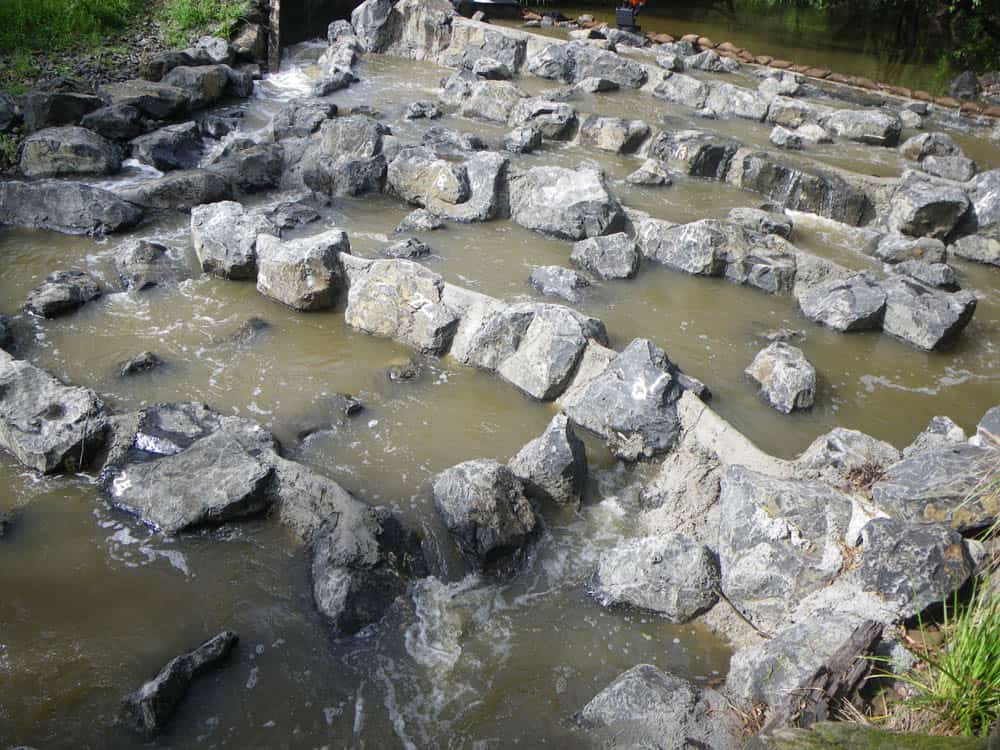A fish not seen in the Bremer River for 14 years is back in record numbers following construction of Queensland’s longest fish ladder.
The 90m-long fish ladder at Berry’s Weir at Yamanto in the river’s lower reaches was completed in late 2016 with monitoring undertaken since to assess its impact.
The weir is at the bottom of the fresh water/tidal section just before the river becomes a tidal estuary.
The results have been remarkable, with one monitoring session earlier this year including the catch and release of more than 1,000 juvenile Freshwater mullet, at a rate of 266 per day.
Fisheries biologist Matt Moore of Catchment Solutions, which built the fish ladder, said the results told a compelling story.
“Fourteen years of fish surveys in the Bremer Catchment have not detected Freshwater mullet, so to catch more than 1,000 in a week is an incredible result,” Mr Moore said.

“Over the years, man-made barriers to fish migration have reduced populations of Freshwater mullet and many other native species.
“The fact that we are finding Freshwater mullet now means the Bremer’s 90m long, rock-ramp fish ladder is really starting to show results.
“It is helping our native fish move easily upstream to complete their life cycle.”
Berry’s Weir was built in the 1960s to impound water for power generation and formed a major barrier to fish migration.
The fishway provides a series of steps and pools in a ‘natural’ rock formation that allow fish to easily ascend over the barrier, in this case the weir, by swimming, stopping for a rest and swimming again.
Across two monitoring days held since the fish ladder was completed, more than 16,000 fish were captured at a rate of 4,075 per day.
Of 15 different species captured, only one was not native. The median size of fish passing through the fish ladder was 34mm.
“This highlights the use of the fish ladder by juvenile fish, which are generally weaker swimmers than the adults,” Mr Moore said.
“To get these kinds of numbers is testament to the success of the fishway. Berry’s Weir has historically been a huge obstacle to our native fish.”
Importantly, adult Australian bass were also found upstream of the weir. Australian bass are economically and socially important species from a recreational angling perspective and need to move from fresh water to salt water to breed.
Another important species, Mary river cod, was also released into the river as part of a stocking project.
“The proof is in the numbers – thanks to the proactive steps taken by Ipswich City Council and (weir owners) Stanwell, we are seeing more of our native fish breed and move upstream from Moreton Bay to the freshwater reaches of the Bremer,” Mr Moore said.
More weirs on ‘hit list’
A recent report ranked the top 50 fish passage barriers in South-East Queensland.
Among the top 50 were seven barriers in the Ipswich local government area.
The barriers identified were on Warrill Creek, Bundamba Creek, Bremer River, Woogaroo Creek and Six Mile Creek.
Already, one of the barriers on Bundamba Creek at Raceview has been removed with a small weir limiting water flow replaced with a rock-ramp fish passageway.
Read more about Berry’s Weir fishway here.

A series of steps and pools in a ‘natural’ rock formation that allow fish to easily ascend over the barrier, in this case the weir, by swimming, stopping for a rest and swimming again.






4.5
5